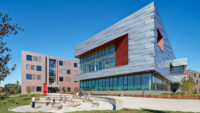Green Building
USGBC Ranks Colorado and Utah in Top 10 of US States for 2015 LEED Green Buildings
Rankings are based on per capita square footage of LEED-certified projects last year

As the only maintenance facility for the Regional Transportation District’s new commuter rail system, the 230,000-sq-ft, LEED-Gold Commuter Rail Maintenance Facility will allow the agency and its contractor, Denver Transit Partners, to service, inspect and maintain a fleet of up to 80 electrified, multiple-unit cars.
Photo courtesy of RTD
The U.S. Green Building Council recently released its national list of the top states in the country for LEED green building in 2015, and both Colorado and Utah were ranked in the top ten. Colorado is ranked 5th on the current list while Utah placed 10th.
Utah is a newcomer on the annual list, illustrating how LEED is expanding beyond states with densely populated urban areas. And after a three-year hiatus, Texas, Washington and Nevada again made the list.
“We are thrilled to have Utah businesses and institutions recognized in this way for the first time,” says Daniel Pacheco, executive director, USGBC Utah Chapter. Utah had 31 projects certified in 2015, representing 4,494,301 sq ft of real estate, or 1.63 sq ft per resident.
Colorado had 95 projects certified last year, representing 12,218,992 sq ft of real estate, or 2.43 sq ft per resident. “With a focus on health and the built environment, Coloradans are persistently blazing a trail for LEED certifications and sustainable building,” says Patti Mason, executive director, USGBC Colorado Chapter.
The annual USGBC ranking is developed by analyzing each state in terms of square feet of LEED-certified space per state resident. Now in its sixth year, the list highlights states throughout the country that made strides in sustainable building design, construction and transformation throughout 2015.
In addition, data from USGBC’s 2015 Green Building Economic Impact Study show LEED construction is expected to support 166,000 total jobs in Colorado and have a construction impact on employment of $281 million between 2015 and 2018. In Utah, green construction over the next three years will add 98,000 total jobs and boost construction employment impacts by $165 million, according to the USGBC report.
The report also estimates that the LEED construction economic impact on overall state GDP from 2015-18 in Colorado will be $9.05 billion and $1.97 billion in Utah.
A few of the notable projects certified in Colorado in 2015 included:
- Republic Plaza, Denver — LEED Gold
- Granite Tower, Denver — LEED Gold
- Commuter Rail Maintenance Facility, Denver — LEED Gold
- North Colorado Springs Readiness Center, Colorado Springs — LEED Platinum
- Laurel Village Residence Halls (LEED Gold) and Laurel Village Pavilion (LEED Platinum), Colorado State University
- Pueblo County Judicial Center — LEED Silver
- City of Boulder Fire Station 8 — LEED Silver
Notables from Utah were:
- Salt Lake City Public Safety Building — LEED Platinum
- U.S. District Courthouse, Salt Lake City — LEED Gold
- Univ. of Utah Football Center — LEED Silver
- Ballet West, Salt Lake City — LEED Gold
The rankings come at a time when states are looking to reduce their energy use. LEED-certified spaces use less energy and water resources, save money for families, businesses and taxpayers, reduce carbon emissions and create a healthier environment for residents, workers and the larger community.
“LEED creates jobs and increases opportunities for workers and businesses while contributing billions of dollars to the states’ economy,” said Rick Fedrizzi, CEO and founding chair of USGBC. “LEED has become an essential standard for the transformation of building design and construction. LEED certified buildings drive economic growth, creates jobs and makes communities healthier.”
Across the U.S., 1,633 commercial and institutional projects became LEED certified within the top 10 ranked states in 2015, according to the USGBC report. That represents 274.9 million sq ft of real estate. Worldwide, 4,837 projects were certified in 2015, representing 818.9 million sq ft. Nearly 75,000 projects representing 14.4 billion sq ft of space have been LEED certified to date.
USGBC calculates the annual LEED ranking using per-capita figures as a measure of the human element of green building. This also allows for fair comparisons among states with significant differences in population and numbers of buildings.
Here are the top 10 states, ranked in order by per capita square footage of their LEED-certified projects during 2015:
- Illinois, 161 projects, 3.43 per capita square footage
- Maryland, 127 projects, 3.06
- Massachusetts, 112 projects, 3.03
- Washington, 101 projects, 2.60
- Colorado, 95 projects, 2.43
- Nevada, 30 projects, 2.42
- California, 618 projects, 2.34
- Texas, 237 projects, 2.09
- Virginia, 121 projects, 1.63
- Utah, 31 projects, 1.63
-
Washington, D.C. (84 projects, 19.30) is not ranked because it is a federal district, not a state.

